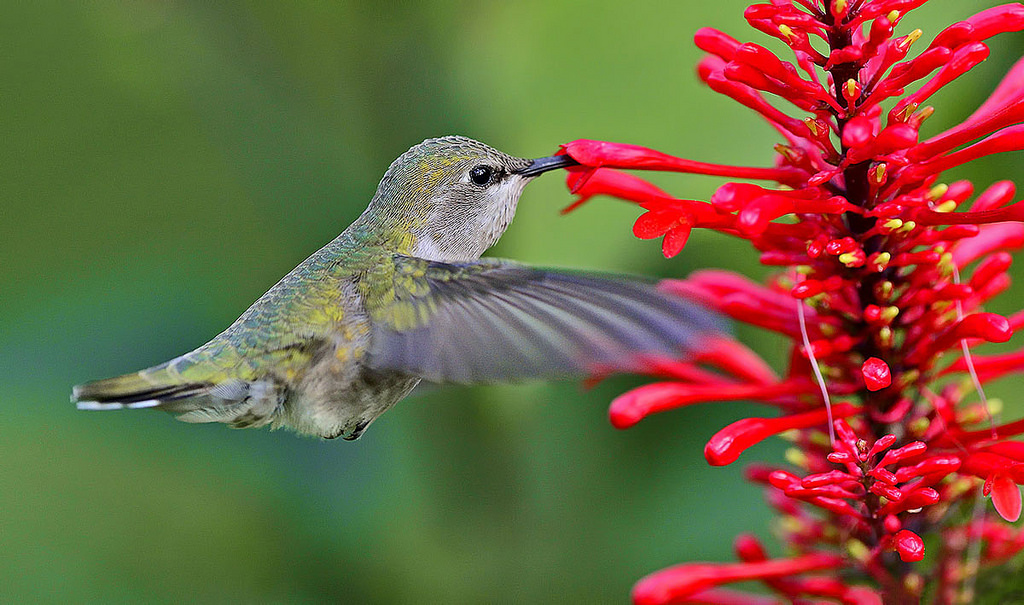
by Sheila Dunning | Oct 4, 2021
 Looking to add something to brighten your landscape this autumn? Firespike (Odontonema strictum) is a prolific fall bloomer with red tubular flowers that are very popular with hummingbirds and butterflies. Its glossy dark green leaves make an attractive large plant that will grow quite well in dense shade to partial sunlight.
Looking to add something to brighten your landscape this autumn? Firespike (Odontonema strictum) is a prolific fall bloomer with red tubular flowers that are very popular with hummingbirds and butterflies. Its glossy dark green leaves make an attractive large plant that will grow quite well in dense shade to partial sunlight.
In frost-free areas firespike grows as an evergreen semi-woody shrub, spreads by underground sprouts and enlarging to form a thicket. In zones 8 and 9 it usually dies back to the ground in winter and re-sprouts in spring, producing strikingly beautiful 9-12 inch panicles of crimson flowers beginning at the end of summer and lasting into the winter each year.
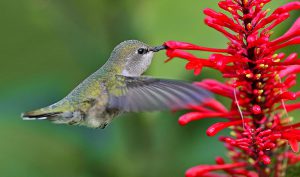 Firespike is native to open, semi-forested areas of Central America. It has escaped cultivation and become established in disturbed hammocks throughout peninsular Florida, but hasn’t presented an invasive problem. Here in the panhandle, firespike will remain a tender perennial for most locations. It can be grown on a wide range of moderately fertile, sandy soils and is quite drought tolerant. Firespike may be best utilized in the landscape in a mass planting. Plants can be spaced about 2 feet apart to fill in the area quickly. It is one of only a few flowering plants that give good, red color in a partially shaded site. The lovely flowers make firespike an excellent candidate for the cutting garden and is a “must-have” for southern butterfly and hummingbird gardens. Additional plants can be propagated from firespike by division or cuttings. However, white-tailed deer love firespike too, and will eat the leaves, so be prepared to fence it off from “Bambi”.
Firespike is native to open, semi-forested areas of Central America. It has escaped cultivation and become established in disturbed hammocks throughout peninsular Florida, but hasn’t presented an invasive problem. Here in the panhandle, firespike will remain a tender perennial for most locations. It can be grown on a wide range of moderately fertile, sandy soils and is quite drought tolerant. Firespike may be best utilized in the landscape in a mass planting. Plants can be spaced about 2 feet apart to fill in the area quickly. It is one of only a few flowering plants that give good, red color in a partially shaded site. The lovely flowers make firespike an excellent candidate for the cutting garden and is a “must-have” for southern butterfly and hummingbird gardens. Additional plants can be propagated from firespike by division or cuttings. However, white-tailed deer love firespike too, and will eat the leaves, so be prepared to fence it off from “Bambi”.

by Daniel J. Leonard | Sep 9, 2021
Bulbs are my favorite class of ornamental plants. They generally are low maintenance, come back reliably year after year, and sport the showiest flowers around. While many bulbs like Daylily, Crinum and Amaryllis are very common in Panhandle landscapes, there is a lesser-known genus of bulbs that is well worth your time and garden space, the Rainlily (Zephyranthes spp.).
Rainlily, aptly named for its habit of blooming shortly after summer rainfall events and a member of the Amaryllis family of bulbs, is a perfect little plant for Panhandle yards for several reasons. The plant’s genus name, Zephyranthes – which translates to English as “flowers of the western winds”, hints at the beauty awaiting those who plant this lovely little bulb. From late spring until the frosts of fall, Rainlily rewards gardeners with flushes of trumpet-shaped flowers in shades of white, pink, and yellow, with some hybrids offering even more exotic colors. While these individual flowers typically only persist for a day or two, they are produced in “flushes” that last several days, extending the show. Though Rainlily flowers are the main event for the genus, beneath the blooms, plants also offer attractive, grass-like, evergreen foliage. These aesthetic attributes lend themselves to Rainlily being used in a variety of ways in landscapes, from massing for summer color ala Daylilies, to use around the edges of beds as a showy border like Liriope or other “border” type grassy plants.
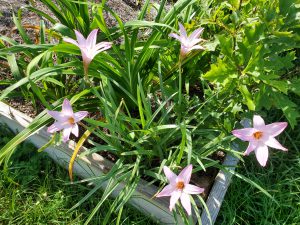
Unknown Rainlily species blooming in a raised bed. Photo courtesy of Daniel Leonard.
Continuing along the list of Rainlily attributes, the genus doesn’t require much in the way of care from gardeners either. Most species of Rainlily, including the Florida native Z. atamasca, have no serious pests and are right at home in full sun to part shade. Once established, plants are exceedingly low-maintenance and won’t require any supplemental irrigation or fertilizer! Some Rainlily species like Z. candida even make excellent water or ditch garden plants, preferring to have their feet wet most of the year – putting them right at home in the Panhandle this year. And finally, all Zephyranthes spp. do very well in containers and raised beds also, adding versatility to their use in your landscape!
The one drawback of Rainlily is that they can be somewhat difficult to find for sale. As these bulbs are an uncommon sight in most garden centers, to source a specific Zephyranthes species or cultivar, one is probably going to need to purchase from a specialty internet or mail-order nursery. As with other passalong-type bulbs though, the absolute best and most rewarding way to obtain Rainlily is to get a dormant season bulb division from a friend or fellow gardener who grows them. There are many excellent unnamed or forgotten Zephyranthes cultivars and seedlings flourishing in gardens across the South, waiting to be passed around to the next generation of folks who will appreciate them!
Even if you must go to some lengths to get a Rainlily in your garden, I highly recommend doing so! You’ll be rewarded with years of low-maintenance summer color after the dreariest of rainy days and will be able to pass these “flowers of the western wind” on to the next gardening generation. For more information on growing, sourcing, or propagating Rainlilies, check out this EDIS publication by Dr. Gary Knox of the UF/IFAS North Florida Research and Education Center (NFREC) or contact your local UF/IFAS Extension office! Happy Gardening!
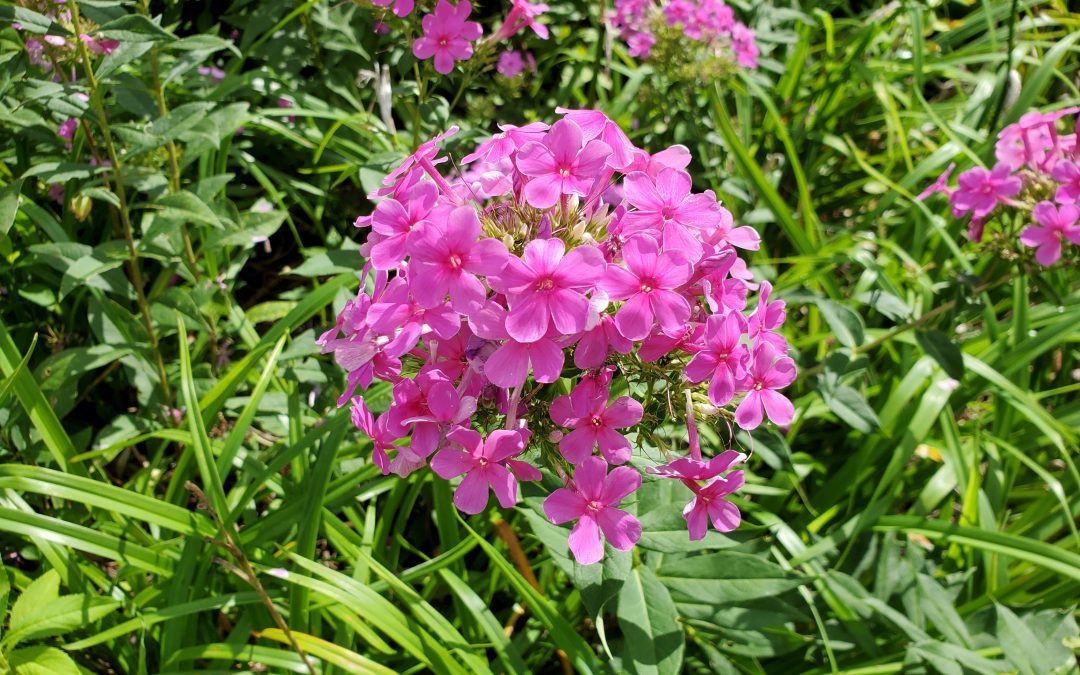
by Daniel J. Leonard | Aug 5, 2021
The number one request all would-be gardeners and budding landscape enthusiasts have is “I want something that I don’t have to take care of, tolerates the heat, blooms, and comes back every year”. That is a tall order in our climate but not an impossible one, especially if one is willing to take a step back in time and consider an old Southern passalong plant, Garden Phlox (Phlox paniculata)!

Garden Phlox (Phlox paniculata) in a Calhoun County landscape. Photo courtesy of Daniel Leonard.
This old heirloom perennial is an outstanding ornamental for Panhandle landscapes. Every spring, Garden Phlox emerges from a long winter sleep and shoots its attractive bright green foliage straight up, reaching 3-5’ in height. After hiding inconspicuously in the landscape all spring, Phlox then blasts into fiery magenta bloom during the heat of summer, beginning the show in late June. While individual Phlox flowers are only 1” wide or so, they are held prominently above the plant’s foliage in large clusters up to 8” in diameter and are about as eye-catching as flowers come. The flower show continues through July and August until finally fading out as fall rolls around. Plants then set seed and ready themselves for winter dormancy, repeating the cycle the following spring. A bonus, though individual Phlox plantings start off as small, solitary clumps, they slowly expand over the years, never over-aggressively or unwanted, into a mass of color that becomes the focal point of any landscape they occupy!
In addition to being gorgeous, Phlox is adaptable and demands very little from gardeners. The species prefers to be sited in full, blazing sun but can also handle partial shade. Just remember, the more shade Phlox is in, the fewer flowers it will produce. Site accordingly. Phlox is also extremely drought tolerant, thriving in most any semi-fertile well-drained soil. Though it can handle drought like a champ, Phlox will languish if planted in a frequently damp location. If water stands on the planting site for more than an hour or so after a big rain event, it is most likely too wet for Phlox to thrive. Once established, Phlox is not a heavy feeder either. A light application of a general-purpose fertilizer after spring emergence from winter dormancy will sustain the plants’ growth and flowering all summer long!
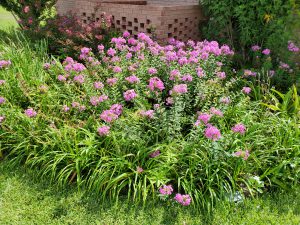
Clump of Garden Phlox in a Calhoun County landscape. Photo courtesy of Daniel Leonard.
Though the ornamental and low-maintenance attributes of plain Garden Phlox make it sound like a perfect landscape plant, it is uncommon in the modern nursery trade, having fallen out of favor as many old plants often do. The species is still a familiar site around old home places, cemeteries, abandoned buildings, and the like throughout the South, but is difficult to find in most commercial nurseries. The primary reason for this is that the commercially available modern Phlox hybrids sporting exotic flower colors and shapes are not tolerant of our growing conditions. These new Garden Phlox hybrids were bred to perform in the milder conditions of more norther climes and are extremely susceptible to the many fungal diseases brought on by Florida’s heat and humidity of summer, particularly Powdery Mildew. It’s best to avoid these newcomers and stick to the old variety with its pink flowers and ironclad constitution. Plain old Garden Phlox can be found in some independent and native plant nurseries, but the best and most rewarding method of acquisition is to make friends with someone that already has a clump and dig up a piece of theirs!
If you have been looking for a low-maintenance, high impact perennial to add to your landscape, old-fashioned Garden Phlox might be just the plant for you! For more information on Garden Phlox, other landscape perennials, passalong plants or any other horticultural topic, contact your local UF/IFAS County Extension Office. Happy Gardening!

by Mary Salinas | Jul 15, 2021
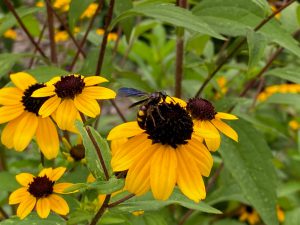
Brown-eyed Susan makes a nice addition to a pollinator garden. This one is visited by a scoliid wasp, a parasitoid of soil-inhabiting scarab beetle larvae. Photo credit: Mary Salinas, UF/IFAS Extension.
Black-eyed Susan, Rudbeckia hirta, has been a very popular garden perennial for generations. Fewer gardeners have experience with, or even heard of its’ close relative, brown-eyed Susan, Rudbeckia triloba. So, what is the difference between them?
- Brown-eyed Susan has more numerous flowers and generally flowers for a longer period in spring, summer, and fall.
- Black-eyed Susan has bigger flowers and bigger leaves.
- Both species are perennial, but the brown-eyed Susan tends to die out sooner after a few years. The good news is that both readily spread through seed to replace older plants.

Brown-eyed Susan. Photo credit: Mary Salinas, UF/IFAS Extension.
Brown-eyed Susan is native to the eastern and central United States and, although native to Florida, it has only been vouchered in the wild in 5 counties in Florida. Gardeners can find seed and plants readily online and at a few native plant nurseries. It is best to try to source wildflower seed from plants grown in the same region. Brown-eyed Susan seed from plants grown in Nebraska or Michigan may not be as well adapted to the Florida environment as locally grown seed.
If you want to add this pollinator attracting perennial to your garden, choose a spot that is sunny or partly sunny. Although it prefers moist soil, brown eyed Susan adapts to most soil types and is drought tolerant after establishment.
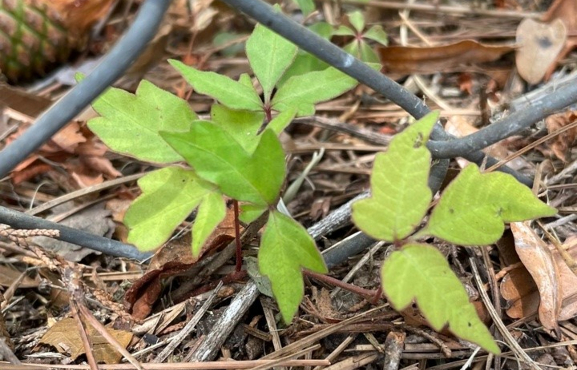
by Pat Williams | Jul 1, 2021
We work very hard to maintain our gardens and then we look up and vines are growing 20′ into the trees. I get asked frequently “what is growing up my trees?” My first answer is “probably the same things growing on your fences.” These include Smilax species, commonly called catbrier or greenbrier, Vitis rotundifolia, referred to as wild muscadine grape, Parthenocissus quinquefolia or Virginia Creeper, and the one to be most careful with, Toxicodendron radicans, known by many as Poison Ivy.
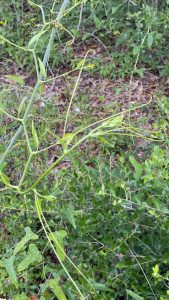
Spring growth on the Smilax vine.
Smilax is a native vine that grows quickly in spring and all summer. There are 12 species in Florida and 9 species commonly found in the Panhandle. Besides being armed with thorns on their stems and some leaves, Smilax spreads by underground stems called rhizomes. If you choose to ignore it, some species can cover your trees and the stems become woody and hard to remove. This vine also produces fruit and seeds are dispersed by birds all while the underground rhizomes are spreading under your lawns and gardens.

Smilax can quickly cover a tree trunk.
Removal can be difficult and mowing the vines only encourages more growth. When trying to remove by hand, wear heavy leather gloves and some eye protection because of the thorns. Cut the stems about three feet above the ground which allows you some stem to pull on to bring it out of your tree. You also then have a handle to pull and try to remove some of the rhizome from underground. Digging rhizomes is time consuming, but gives you piece of mind that they won’t come back immediately. Our family actually harvests the new shoots in spring and we use them like asparagus.
Wild muscadine grape is also native and difficult to remove. Most of the vines in nature are male and only produce by runners along the ground and then grow upwards. The female vine can produce 4-10 grapes in a cluster and then reseeds itself.
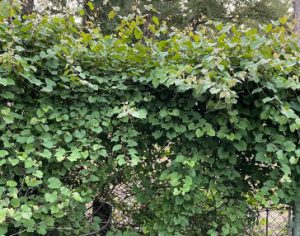
Wild muscadine grape covering a fence.
Wild grape completely covers plants and eventually the plants underneath can die. There are no thorns to contend with when removing wild grape, it is just time consuming, especially if it has taken over your fence or natural areas.
Virginia Creeper is a native vine, still considered a nursery plant in some areas of the country, and has bright red fall color.
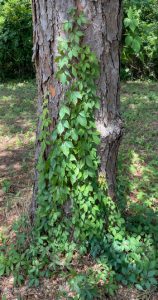
Virginia Creeper climbing a tree trunk.
It is most often confused with poison ivy because of having five leaflets per leaf whereas poison ivy only has three leaflets per leaf. It spreads by seeds, runs along the ground, and is the easiest of these four vines to remove from your property.
Poison Ivy is a native vine distinguished by its three leaflets with the individual leaflets getting up to 6″ long. This vine spreads by seeds and underground rhizomes. What makes removal of this vine difficult is the urushiol oils which causes the skin rashes and blistering.
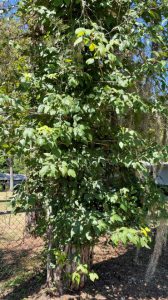
Poison ivy covering a tree trunk.
Care must be taken to cover up all skin and I recommend wearing waterproof clothes versus cotton which can absorb the oils and transfer them to your skin. Under no circumstances should these vines be put on the burn pile, the oils can become airborne and then you can inhale them.
Here are a few helpful tips when battling these native vines. First have patience and be dedicated, this removal will not happen over night. It may take a year or two to rid your property of the original vines. Be diligent though, because birds will continually land in your trees and deposit more seeds to get a fresh start. Try to remove vines when they are young and just beginning to climb your trees and fences. If you know you don’t have the time or energy to remove the vines from all your trees, at least cut the vines close to the ground to reduce flowering and new seeds. Be careful with poison ivy because falling leaves still contain oils. Once the vines start to have a new flush of growth, spray a non-selective herbicide on new growth and you should have good results. Lastly, remember one person can make a difference in trying to reduce the number of nuisance vines in our communities.
Here are some sited references to help with your removal tasks. Key to Nine Common Smilax Species of Florida. https://edis.ifas.ufl.edu/publication/fr375. Smilax is a Vine that can be Difficult to Control. http://blogs.ifas.ufl.edu/wakullaco/2017/04/21/smilax-is-a-vine-that-can-be-difficult-to-control/. The Muscadine Grape (Vitus rotundifolia Michx.) https://edis.ifas.ufl.edu/publication/hs100. Muscadine Grape Vines: Difficult to Control in Your Landscape. http://blogs.ifas.ufl.edu/wakullaco/2017/03/24/muscadine-grape-vines-difficult-to-control-in-your-landscape/. Parthenocissus quinquefolia: Virginia Creeper https://edis.ifas.ufl.edu/publication/fp454. Identification of Poison Ivy, Poison Oak, Poison Sumac, and Poisonwood. https://edis.ifas.ufl.edu/publication/EP220.
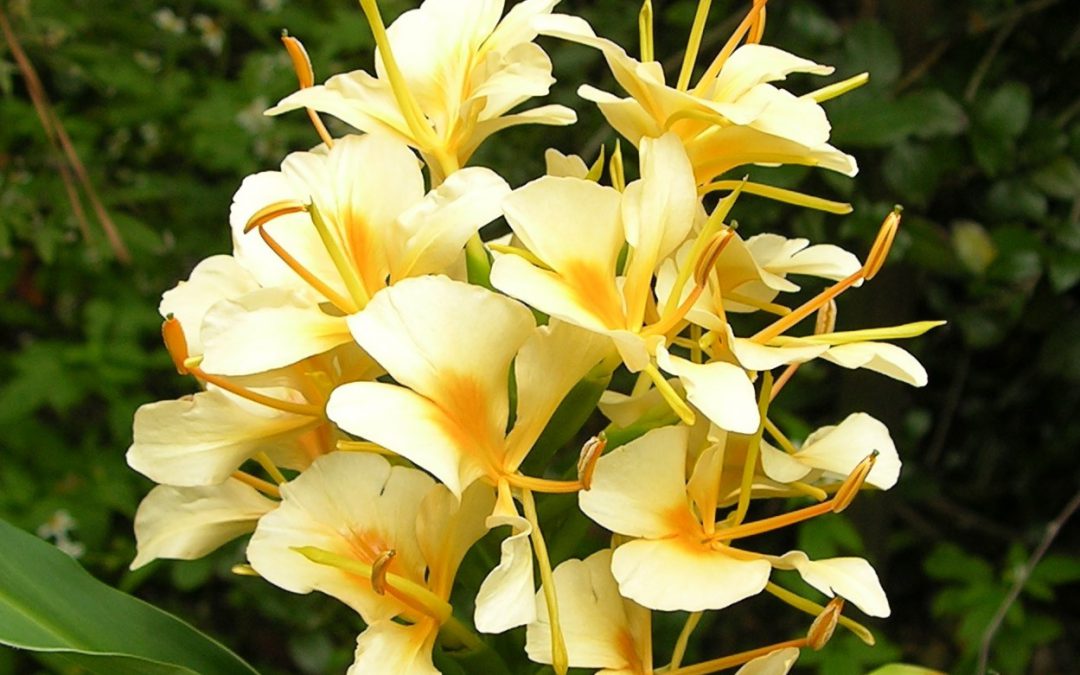
by Gary Knox | Jun 17, 2021
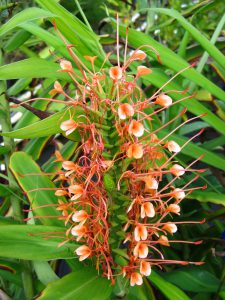
‘Disney’ scarlet ginger lily produces beautiful orange flower clusters atop stems growing up to 7 feet in height
If you’re looking for colorful flowers with superpowered fragrance, look no farther than ginger lily (Hedychium sp.). This group of plants packs a punch with big, bright flowers, intoxicating fragrance and bold tropical foliage, all in a robust herbaceous perennial that is perfectly hardy in north Florida.
Ginger lilies are tropical and subtropical plants in the Zingiberaceae (Ginger) Family. They produce fragrant, colorful, complex flowers and often other plant parts also are aromatic. Ginger lily flowers appear in racemes or spikes at the tops of cane-like stems 4 to 6 feet or more in height. Flowering summer until frost, the clumps of upright stems grow from thick rhizomes that creep underground just below the soil surface. Native to Asia and related to the spice, true ginger (Zingiber officinale), ginger lilies will add color, fragrance and a tropical vibe to your home garden.
Ginger lilies grow best in full to part sun in rich, moist, well-drained soil. New stems emerge in late spring and quickly grow into upright stems with long, bold-textured leaves held horizontally or angled upright. The cane-like stems are topped with clusters of large, bright colored flowers starting in late spring to mid summer, often continuing through fall. Frosts or freezes will kill the above-ground stems, but rhizomes easily overwinter temperatures as low as 0°F (making them hardy into USDA Cold Hardiness Zone 7b) and produce new growth in late spring once warm weather resumes. Few pests or diseases affect ginger lily, and the only regular maintenance is to cut and remove the dead stems in late winter before new growth emerges.
Butterfly ginger is the type most widely grown and frequently shared as a pass-along plant. Butterfly ginger (Hedychium coronarium) is grown for its large fragrant white flowers. It grows 4 to 5 feet high and begins flowering in mid to late summer, continuing through fall. With a heavy sweet fragrance, a flowering clump of butterfly ginger smells heavenly in the garden and, as a cut flower, will easily perfume a large room! Butterfly ginger is not picky about growing conditions but prefers moist, good garden soil. This is the ginger flower most often used to make Hawaiian leis!
There are dozens of species and cultivars of Hedychium. Some of the ginger lilies that are often found in local nurseries or Master Gardener plant sales are listed below.
‘Dr. Moy’ variegated ginger lily (Hedychium ‘Dr. Moy’) is distinguished by white paint-like splashes on its leaves and fragrant, peachy-orange flowers. ‘Dr. Moy’ produces its first round of flowers from mid-July to August and a second crop in late-September to October.
‘Daniel Weeks’ ginger lily (Hedychium ‘Daniel Weeks’) is a perennial tropical ginger hybrid from Florida’s Russell Adams with hardiness to Zone 7. Growing to 6 to 7 feet high, it produces large dark throated golden-yellow inflorescences with the bonus of delightful evening fragrance. This vigorous clumping hardy ginger lily is the longest blooming, starting in early to mid summer and continuing to frost. It is considered by many as one of the best of all ginger lilies.
‘Disney’ scarlet ginger lily (Hedychium coccineum ‘Disney’) produces large, bright orange flower clusters on tall stems up to 7 feet in height. Foliage is very glossy with a reddish hue, and the overall effect of the clump of stems is very upright. Typically, all stems flower at the same time followed by a resting period before flowering again.
‘Pink Sparks’ ginger lily (Hedychium ‘Pink Sparks’) is a compact variety only growing 4 to 5 feet high. Terminal inflorescences are made up of many small bright pink flowers with very long stamens.
Ginger lily may be propagated by digging and dividing clumps or by cutting off sections of rhizome (making sure each section has at least one bud) and placing these in new locations for sprouting and growth. It’s best to divide or propagate plants before late summer so divisions have enough time to develop a new root system and/or stems before the cooler weather of fall slows growth.
References
Carey, Dennis and Tony Avent. 2010. Hedychium – A Hardy Ginger Plant for the Garden. Plant Delights Nursery, Inc., Raleigh, NC 27603. https://www.plantdelights.com/blogs/articles/ginger-plant-lily-variegated-hedychium-lilies. Accessed 9 June 2021.
Gilman, Edward F. 2015. Hedychium coronarium Butterfly Ginger, FPS-240. Environmental Horticulture Department, UF/IFAS Extension, Gainesville, FL 32611. Original publication date October 1999. Reviewed February 2014. FPS-240/FP240: Hedychium coronarium Butterfly Ginger (ufl.edu). Accessed 9 June 2021.

 Looking to add something to brighten your landscape this autumn? Firespike (Odontonema strictum) is a prolific fall bloomer with red tubular flowers that are very popular with hummingbirds and butterflies. Its glossy dark green leaves make an attractive large plant that will grow quite well in dense shade to partial sunlight.
Looking to add something to brighten your landscape this autumn? Firespike (Odontonema strictum) is a prolific fall bloomer with red tubular flowers that are very popular with hummingbirds and butterflies. Its glossy dark green leaves make an attractive large plant that will grow quite well in dense shade to partial sunlight. Firespike is native to open, semi-forested areas of Central America. It has escaped cultivation and become established in disturbed hammocks throughout peninsular Florida, but hasn’t presented an invasive problem. Here in the panhandle, firespike will remain a tender perennial for most locations. It can be grown on a wide range of moderately fertile, sandy soils and is quite drought tolerant. Firespike may be best utilized in the landscape in a mass planting. Plants can be spaced about 2 feet apart to fill in the area quickly. It is one of only a few flowering plants that give good, red color in a partially shaded site. The lovely flowers make firespike an excellent candidate for the cutting garden and is a “must-have” for southern butterfly and hummingbird gardens. Additional plants can be propagated from firespike by division or cuttings. However, white-tailed deer love firespike too, and will eat the leaves, so be prepared to fence it off from “Bambi”.
Firespike is native to open, semi-forested areas of Central America. It has escaped cultivation and become established in disturbed hammocks throughout peninsular Florida, but hasn’t presented an invasive problem. Here in the panhandle, firespike will remain a tender perennial for most locations. It can be grown on a wide range of moderately fertile, sandy soils and is quite drought tolerant. Firespike may be best utilized in the landscape in a mass planting. Plants can be spaced about 2 feet apart to fill in the area quickly. It is one of only a few flowering plants that give good, red color in a partially shaded site. The lovely flowers make firespike an excellent candidate for the cutting garden and is a “must-have” for southern butterfly and hummingbird gardens. Additional plants can be propagated from firespike by division or cuttings. However, white-tailed deer love firespike too, and will eat the leaves, so be prepared to fence it off from “Bambi”.















